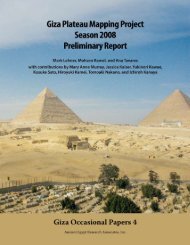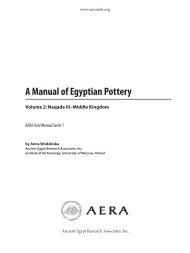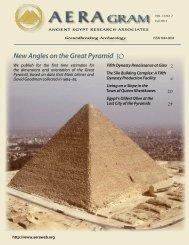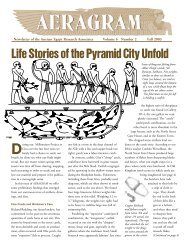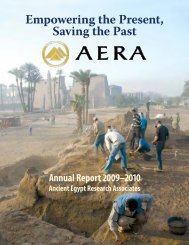Spring 2008 - Ancient Egypt Research Associates
Spring 2008 - Ancient Egypt Research Associates
Spring 2008 - Ancient Egypt Research Associates
You also want an ePaper? Increase the reach of your titles
YUMPU automatically turns print PDFs into web optimized ePapers that Google loves.
A sphinx base with inscription of Nectanebo I (380–362 BCE). (Photo by Yukinori Kawae)<br />
From Giza to Luxor<br />
The story begins with an urgent plea from the SCA General<br />
Director of Luxor, Mansour Boraik, former Chief Inspector at<br />
Giza, good friend of AERA, and Field School Supervisor. He<br />
sent out a call for help with the rescue excavations launched<br />
in November 2005 along the Avenue of the Sphinxes. The<br />
famous avenue once ran the 2.7 kilometers between Luxor and<br />
Karnak Temples. One of the last native <strong>Egypt</strong>ian pharaohs,<br />
Nectanebo I, lined the avenue with sandstone sphinxes on<br />
pedestals every 5 meters interspersed with trees.<br />
A development plan of recent years for greater Luxor called<br />
for excavating much of the remainder of the avenue right<br />
through, and under modern Luxor, which sits upon many<br />
layers of ancient Thebes, one of the preeminent cities of the<br />
ancient world. Although <strong>Egypt</strong>ologists have been excavating<br />
12<br />
AERAGRAM 9/1<br />
A brick-lined tree pit.<br />
(Photo by Yukinori Kawae))<br />
and recording Karnak and Luxor Temple for nearly two centuries,<br />
there has been very little excavation of those parts of<br />
the city where people lived. Many opportunities for excavating<br />
and recording settlement have been lost. For instance, two<br />
thousand years of housing—Medieval Islamic to late Ptolemaic<br />
periods were removed from within, and in front of Luxor<br />
Temple in drastic clearings during the early 19th century and<br />
into the late 1950s. This clearing stopped just before reaching<br />
the Khaled Ibn el-Waleed Garden. Drastic digging began again<br />
in late 2005, with two huge trenches cut through the garden to<br />
expose the sphinxes. A world of systematic, scientific archaeology,<br />
especially for ancient settlements, has evolved since the<br />
1950s. Knowing this, and having taught in the Field Schools,<br />
Mansour asked AERA and some of the graduates of the AERA<br />
Field Schools for help in early 2006.<br />
The Salvage Archaeology Field School excavations. Luxor Temple is on the far left in the background. View to the southwest. (Photo by Mark Lehner)





